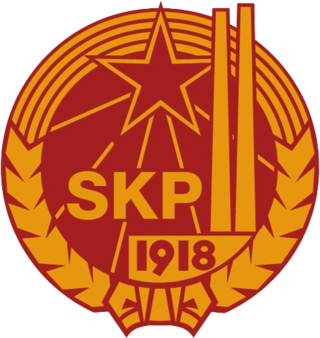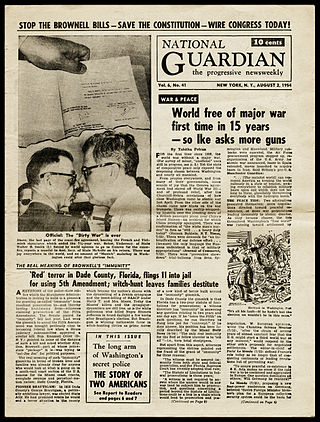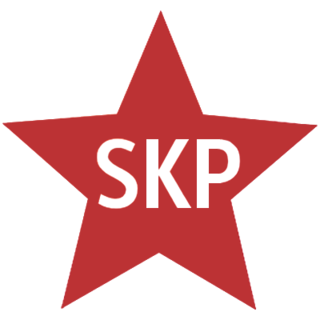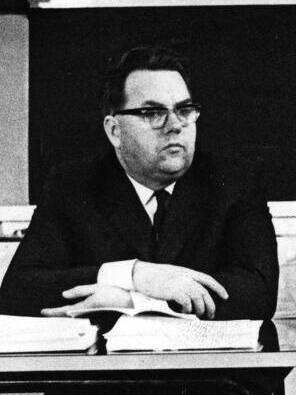Helsingin Sanomat, abbreviated HS and colloquially known as Hesari, is the largest subscription newspaper in Finland and the Nordic countries, owned by Sanoma. Except after certain holidays, it is published daily. Its name derives from that of the Finnish capital, Helsinki, where it is published. It is considered a newspaper of record for Finland.

The Communist Party of Finland was a communist political party in Finland. The SKP was a section of Comintern and illegal in Finland until 1944.
Finnish People's Democratic League was a Finnish political organisation with the aim of uniting those left of the Finnish Social Democratic Party. It was founded in 1944 as the anti-communist laws in Finland were repealed due to the demands of the Soviet Union, and lasted until 1990, when it merged into the newly formed Left Alliance. At its time, SKDL was one of the largest leftist parties in capitalist Europe, with its main member party, the Communist Party of Finland, being one of the largest communist parties west of the Iron Curtain. The SKDL enjoyed its greatest electoral success in the 1958 parliamentary election, when it gained a support of approximately 23 per cent and a representation of 50 MPs of 200 total, making it the largest party in the Eduskunta.

The National Guardian, later known as The Guardian, was a left-wing independent weekly newspaper established in 1948 in New York City. The paper was founded by James Aronson, Cedric Belfrage and John T. McManus in connection with the 1948 Presidential campaign of Henry A. Wallace under the Progressive Party banner. Although independent and often critical of all political parties, the National Guardian is thought to have been initially close to the ideological orbit of the pro-Moscow Communist Party USA, but this suspected association quickly broke down in the course of several years.
Communist Workers' Party – For Peace and Socialism is a communist party in Finland. It was founded in 1988 to secure the existence of an independent Marxist–Leninist party. Since it was founded, it has not gained seats in the Parliament of Finland, and as a result it has been removed from the Finnish party register and re-registered multiple times. It has been de-registered since 2019.

The Communist Party of Finland (Finnish: Suomen Kommunistinen Puolue, SKP; Swedish: Finlands kommunistiska parti, FKP) or New Communist Party of Finland (Finnish: Uusi Suomen Kommunistinen Puolue, USKP; Swedish: Finlands nya kommunistiska parti, FNKP) is a political party in Finland. It was founded in the mid-1980s as Communist Party of Finland (Unity) (Finnish: Suomen Kommunistinen Puolue (yhtenäisyys), SKPy; Swedish: Finlands kommunistiska parti (enhet), FKP(e)) by the former opposition of the old Communist Party of Finland (1918–1992). SKP has never been represented in the Finnish parliament, but the party has had local councillors in some municipalities, including the city councils of major cities such as Helsinki and Tampere. SKP claims 2,500 members.

Printed media in the Soviet Union, i.e., newspapers, magazines and journals, were under strict control of the CPSU and the Soviet state. The desire to disseminate propaganda was believed to had been the driving force behind the creation of the early Soviet newspapers. Newspapers were the essential means of communicating with the public, which meant that they were the most powerful way available to spread propaganda and capture the hearts of the population. Additionally, within the Soviet Union the press evolved into the messenger for the orders from the CPSU Central Committee to the party officials and activists. Due to this important role, the Soviet papers were both prestigious in the society and an effective means to control the masses; however, manipulation initially was not the only purpose of the Soviet Press.

Arbetar-Tidningen was a communist newspaper from Gothenburg, Sweden, published between 1929 and 1974.
Flamman, also known as Norrskensflamman, is a Swedish socialist weekly newspaper.
Taistoism was an orthodox pro-Soviet tendency in the mostly Eurocommunist Finnish communist movement in the 1970s and 1980s. The Taistoists were an interior opposition group in the Communist Party of Finland. They were named after their leader Taisto Sinisalo, whose first name means "a battle", "a fight" or "a struggle". Sinisalo's supporters constituted a party within a party, but pressure from the Communist Party of the Soviet Union prevented the party from formally splitting. The term taistolaisuus was a derogatory nickname invented by Helsingin Sanomat and was never used by the group themselves.

Taisto Jalo Sinisalo was a Finnish communist politician, MP of the SKDL (1962–1978), leader of the Communist Party of Finland’s hardline pro-Soviet faction and vice chairman of the party (1970–1982). After the SKP split in the 1980s, Sinisalo became the first chairman of the Communist Party of Finland (Unity) (SKPy).
The Young Communist League of Finland was the youth organization of the Communist Party of Finland (SKP) 1925–1936. The organization was clandestine, but had a significant impact in Finnish society. SKNL was a section of the Communist Youth International.

Rya Teze, formerly written as Rja Ţəzə and Р’йа т'әзә, was a Kurdish language newspaper published from Yerevan, Armenia. The newspaper was founded in March 1930 and the first issue was published on 25th March 1930, printed in Kurmanji Kurdish with the newly latinised alphabet of Shemo-Margulov. It was the organ of the Kurdish section of the Communist Party of Armenia, and was produced under the auspices of the Central Committee of the Communist Party of Armenia and the Supreme Council and the Council of Ministers of the Armenian SSR. At the time, it was a four-page newspaper, published twice every week and with a circulation of 600 copies. Prior to the Kurdish linguist and author Cerdoyê Genco taking over as editor in 1934, the newspaper was run by three Armenians born in Western Armenia: Kevork Paris, Hrachya Kochar and Harutyun Mkrtchyan, who knew Kurdish. Publication was discontinued in 1937.

Kansan Uutiset is a Finnish language weekly newspaper published in Helsinki, Finland. It is the party organ of the Left Alliance.
During the nine decades since its establishment in 1919, the Communist Party USA produced or inspired a vast array of newspapers and magazines in at least 25 different languages. This list of the Non-English press of the Communist Party USA provides basic information on each title, along with links to pages dealing with specific publications in greater depth.

For a number of decades after its establishment in August 1901, the Socialist Party of America produced or inspired a vast array of newspapers and magazines in an array different languages. This list of the Non-English press of the Socialist Party of America provides basic information on each title, along with links to pages dealing with specific publications in greater depth.
Suomenmaa is a Finnish language party newspaper published four days a week from Tuesday to Friday in Oulu, Finland.

Raivaaja was a Finnish-language newspaper published from 1905 to 2009 in Fitchburg, Massachusetts, by Raivaaja Publishing Company. For the first three decades of its existence the publication was closely associated with the Socialist Party of America (SPA). In 1936 as part of a large factional split in the SPA, the former Finnish Socialist Federation severed its connection to become the "Finnish American League for Democracy," with Raivaaja remaining the official organ of this remodeled organization.

Land og Folk was a Danish communist newspaper published from 1919 to 1990. It became the main organ of the Communist Party of Denmark (DKP) from 1920 and boomed in circulation during World War II, growing from 12,000 copies in 1940 to 120,000 copies in 1945. The paper was printed in Copenhagen, but distributed countrywide.

Markus Kainulainen was a Finnish communist politician. He was a member of the Central Committee of the Communist Party of Finland (SKP) and served as a Member of the Parliament of Finland from 1975 to 1979 and again from 1982 to 1983, representing the Finnish People's Democratic League (SKDL). After the SKP split in the 1980s, Kainulainen at first joined the Communist Party of Finland (Unity) (SKPy). The SKPy split in 1988 as well and Kainulainen was one of the leading organisers of a new party, Communist Workers' Party – For Peace and Socialism (KTP).












